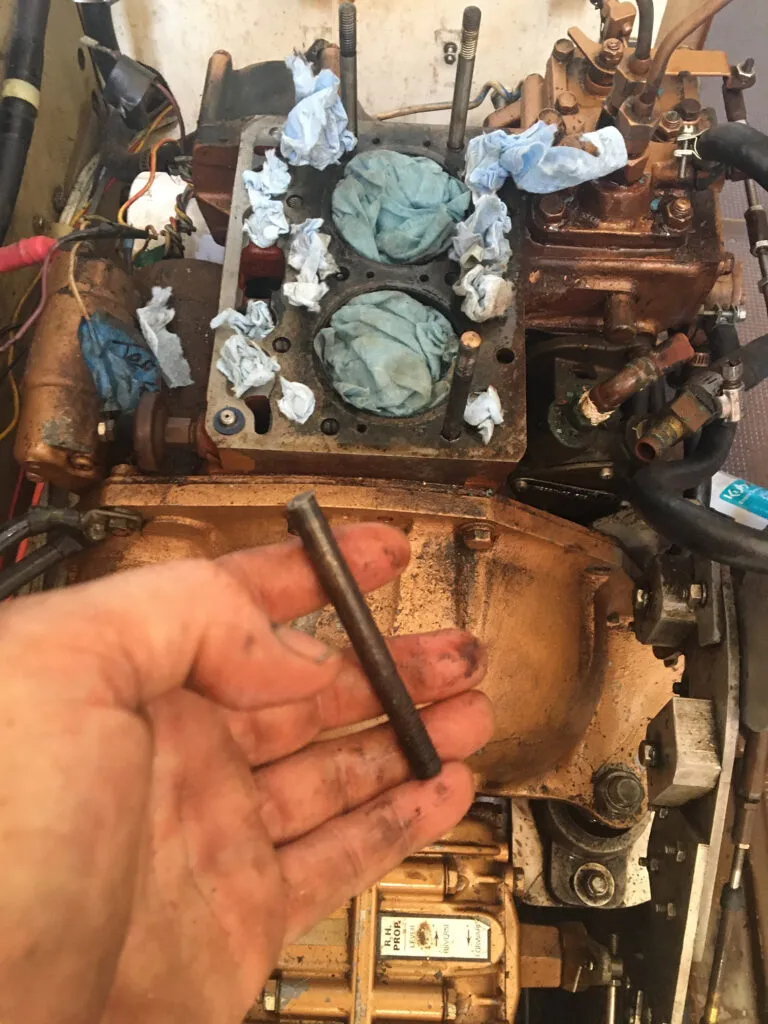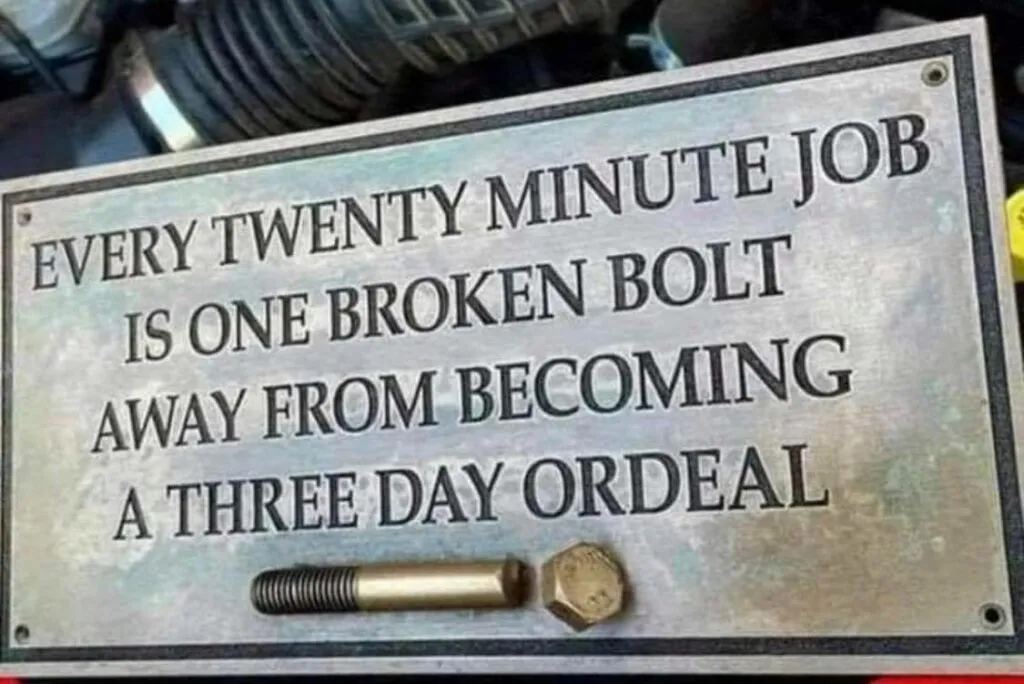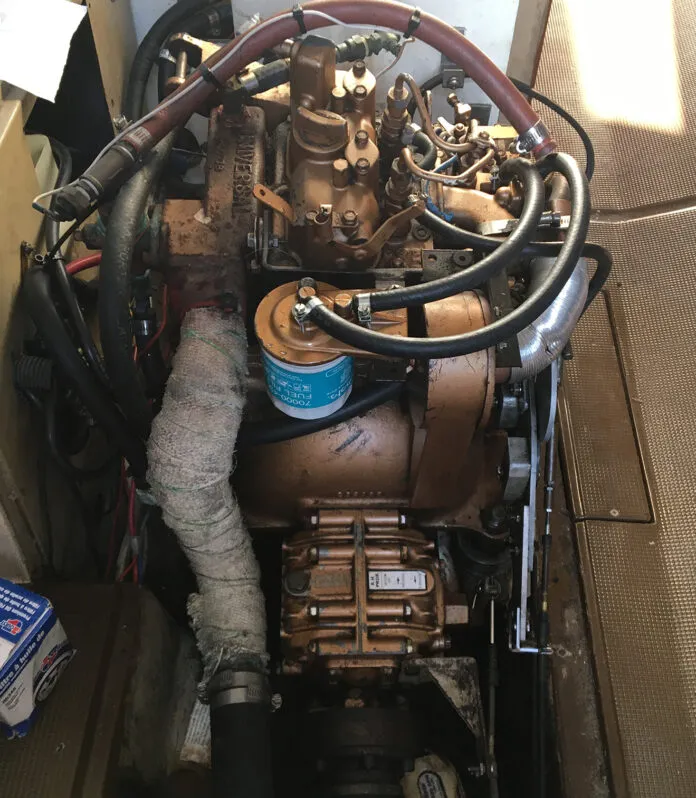If you are the new owner of an old boat and you’re lucky enough to have some money left over, you’ll no doubt feel the temptation to add a few accessories or spiff up the boat’s appearance.
There’s nothing wrong with pride of ownership. In fact, in Florida, where battle-scarred boats are automatically—and often wrongly— associated with troublesome tenants, peeling hull paint can disqualify you from a long-term slip at the local marina.
So go ahead and treat your teak, polish your stainless, and wax your hull if that makes you feel better about your new purchase. While these basic maintenance chores can prevent further deterioration, their impact on longevity is generally overrated. In my view, the best reason to carry out these activities is to alert you to the more pressing issues that should rise to the top of your “to do” list.
- By fretting over your dull stainless, you’ll get the chance to inspect your chainplates, rigging, lifelines, and mast hardware for more serious issues.
- By chasing after golden-hued teak you’ll discover deck leaks, and cracks in coamings, sprits, bulwarks or other structural components.
- By aspiring for hull that gleams, you’ll discover soft spots in the deck, or spidercracks around hardware where deck leaks begin.
For most new owners, these chores are better left until after addressing other priorities—tasks more essential to getting from point A to point B.
Priorities
As I enter the third week of the haulout of Opal, my newly acquired 50-year-old S&S designed Yankee 30, I find myself constantly chasing back the images of beautiful boats that grace calendars and magazine covers—gleaming hulls, blinding white sails, brightwork that catches every glint of sun. Someday Opal may look so grand, but since my time and budget is limited, I recognize that the shortest path toward fun on the water requires tolerating an appearance that is “good enough” and focusing on the important stuff.
So what should we prioritize? In short—anything that will prevent you from safely reaching your next port. This seems obvious, but the source of next breakdown is not always advertised in bright neon, especially to the new owner. And more often than not, the impending calamities lie hidden in the engine room.
I know. We have a sailboat, why worry about the engine? A competent sailor should have the confidence to reach safe harbor under sail alone—although they might need some towing assistance entering a pass, or navigating a narrow channel. And if you are on a mooring with easy access to your sailing waters, the engine can easily drop down in priorities. Several PS readers in similar circumstances actually removed their engines without regret.
A Bit of History
I got my first powerboat when I was 16, shortly after completing a small boat course with the local Coast Guard Auxiliary (I’d already spent several years driving other people’s boats). My father, who helped pay for college by delivering groceries to Mississippi tugs, had decided I’d demonstrated enough responsibility to manage a small fishing skiff (but not a car—go figure). Underneath the keys were three books—the owner’s manual, the workshop manual, and the parts guide to the 50 hp Mercury on the transom. “Read these, front to back,” he said. “And then we can take her out.” I went one step further and also took a small engine class in high school. Outside of my journalism class, that course has served me better than most others I took my junior year.

If you don’t have the workshop manual, parts guide, and owners manual, get your hands on them ASAP. More than likely, you can download a PDF from the manufacturer’s website or some other source on the Internet. Be aware that many of the marine diesel engines, like Opal’s Universal 5411, are used in other industries. (The 5411 is a Kubota Z500 block used in the Kubota B5100 tractors.) So if you can’t find the workshop manual for your “marine” engine, find the terrestrial equivalent, and this will cover most of the essential components except the exhaust, cooling system, and drive train. Knowing your engine’s original manufacturer will save you time and money tracking down parts, especially if you are stranded in a foreign port, where diesel engines are put to more essential uses than powering cruising yachts. (Yes, I do recognize that sailing is essential in its own way.)

References and Resources
Although there may be others, I’ve found two books to be helpful putting me on the road to internal combustion engine self-sufficiency: Nigel Calder’s Marine Diesel Engines, and Ed Sherman’s Outboard Engines: Maintenance, Troubleshooting, And Repair. Calder’s book, first published in 1987, is best used with older, naturally aspirated motors, but it also addresses turbo-charged engines, and it is still largely applicable to newer diesel engines. The common-rail injection systems found in some current models gets less attention. Sherman’s textbook, aimed at the professional, tells you more than you need to know about most small outboards.
One way to learn about your internal combustion engine is to call in a pro to give you an orientation while they go through routine maintenance (oil changes, filter changes, belt tensioning) and less frequent checks such as engine alignment and valve clearance. It’s getting harder to find a good diesel mechanic and get on their schedule, but it is well worth the time and money to hire an expert to go over your engine with you. Not every mechanic is a good teacher though. If you’re having trouble finding help, you might inquire at the local community college or vocational school. More than likely, you’ll find someone in the anchorage who knows your engine better than they had ever intended.
Let the mechanic know that you want some guidance of all the routine service items described in the workshop manual, and work out a deal. If you are lucky, you’ll have someone like Al Ligget in the local anchorage or marina. Al, who had been cruising with his wife Beth for 33 years aboard their Valiant 40 Sunflower when I met them in Guam, helped me rebuild the top end of my Volvo MD2B in Guam and didn’t charge a dime. If you prefer a more formal program, Mack Boring, Hansen Marine, and the Annapolis School of Seamanship others offer diesel mechanic seminars that are invaluable to the cruising sailor.
My Calamity
I’ll close here with a quick tale of disaster nearly averted, in the hopes of saving you the same trouble. After nearly four years of wandering the Caribbean in the early 1990s my partner Theresa and I wound up at the mouth of the Panama Canal, finally feeling ready to tackle the world’s greatest ocean in our 30-foot ketch. We loaded the boat with fuel, food, and water in the Caribbean port of Colon. Riding exceptionally low on the waterline in Gatun Lake’s freshwater, we took two days to transit the canal. We caught our breath in Taboga Island on the Pacific side before the 1,000-mile passage to the Galapagos Islands.
Expecting calms for most of the passage, we set out in a flat calm with 70 gallons of fuel. Six hours later, around mid-day, the engine wailed, screeched, clattered, clanged, and died. Hardly a ripple stirred the Gulf of Panama.
Rather than carry on through a region notorious for its calms, currents, and fickle winds, we hauled out the drifter and ghosted back to Taboga Island, eventually discovering that the cylinder head was cracked. The cause was a broken valve spring, which had corroded over the years. The failed spring allowed the intake valve to drop into the cylinder where the piston promptly hammered it into the cylinder head, causing it to crack.
The valve spring corrosion was probably accelerated by salt or scale buildup in the tiny nitrile diaphragm in the cooling system’s anti-siphon vent, causing it to remain closed, and allowing water to get back into engine. Because the loaded boat had been floating so far below our waterlines in the freshwater canal, this also might have contributed to the problem. Tom Neale has a good description of Anti-siphon Valve Basics on the Boat US website. Another route for water into the engine is past the cooling pump lip seals–and this also might have been a factor.
So in short, our failure to routinely check two common sources of trouble led to what could have been hundreds of dollars in repairs. The old Volvo-MD2B needed a complete top-end rebuild, and the cylinder head needed to be repaired or replaced. Thanks to some enterprising Panamanians and some talented machinists, I was able to source almost everything we needed in Panama City. Except for a few parts that were mailed from the U.S., we substituted machined automotive parts for nearly every component. (All those years of Spanish classes paid off, big time.)
Of course, the Internet and global air transport have made sourcing parts easier these days. And as long you’re stranded near a WiFi connection, Starbucks, or Internet cafe, YouTube videos can help guide you through many repairs (and disrepairs, choose carefully). I’m finding this out as I embark on my latest project: replacing a sheared cylinder bolt that I recently discovered on Opal while replacing the raw water pump impeller. (Funny, how quickly a routine service job can spiral.)

As easy as it was to set the repair in motion with a few mouse-clicks, the experience renewed my respect for wise old salts like Al Liggett, whose wise counsel can’t be replicated in a YouTube video. If you have a book, video, online course, or in-person course to recommend — or just a tale of your own engine misadventure — I’d love to hear about it in the comments below or via email.
If you are looking to avoid one of the most common sources of marine diesel engine, as well as gasoline outboards, we’ve done extensive testing of various marine-fuel additives, and found a few good products that not only keep fuel bugs at bay, but fight corrosion. We also found a few products that fall into the snake oil category.








































Hi Darrell. Great article. Just one question. Was your reference about a “failed Flapper Valve” in reference to your MD2B or your 5411. My reason for the question is because I have a 5411 in my Catalina 27 and am trying to keep it alive even after 38 years of life. I think the only reason it isn’t just a pile of rust is because it has only lived in fresh water. OK, now that I’m asking, how about if needing to heat the glow-plugs for 25-30 seconds is normal? Winter or summer it needs that much heat to kick over. I sail it year round and keep a heater on when the winter water temps get down to when I have to break skim ice. I have removed and checked the heating ability of both the glow-plugs directly on the batteries and they get cherry red. Thanks for your thoughts. Sincerely. Gale Carlson. Lake of the Ozarks.
Gale, the valve comes in many forms, mine was actually a diaphragm valve. I’ve included a link to a good description of the valve, its function and care in the text. Here it is again. https://www.boatus.com/expert-advice/expert-advice-archive/2018/april/anti-siphon-valve-basics Basically, the anti-siphon valve’s purpose is to stop raw cooling water from back-siphoning into the exhaust manifold and into the engine. Marine heads have a similar valve to prevent backflow. I imagine a sticking valve is less of a problem in freshwater, since salt is not present. We suspect ours was probably gummed up before we went into the Panama Canal.
The Universal Diesels have a head construction that does need preheating for easy starting. My Universal 5444 does even in summer. My Perkins 4236, starts first time, no glow plugs. In very cold weather you can burn fuel in the air intake. My Yanmar 3YM30 has glow plugs but unlike the Universal, does not need them in hot weather. It comes back to engine design. So to understand better look at head design. I think on the Universal you will find a pre-chamber in which is the glowplug.
Sailing south in the Sea of Cortez nearly 30 years ago, the sea water pump on my Universal 850 marinized Kubota engine blew out its bearings (back then the standard pump had a grease cup that required frequent attention to keep the bearings and seals from failing) and water spurted out around the impeller shaft. I managed to sail into a slip at Marina de La Paz, unbolted the pump, and visited an automotive repair shop under an outdoor palapa shade structure behind the repairman’s home where young children played in the yard. A very satisfying day began.
The mechanic assured me there were no replacement parts available in Baja for this pump but the shaft and bearing looked much like what the mechanic remembered as Toyota water pump shaft and bearing. We commenced a four hour treck around to all of his sources for such parts and eventually found a machine shop that rebuilt such pumps. While not a perfect fit, the machinist milled my pump housing a bit to accommodate the difference, and assembled it. And “Roberto esta mi tio” (“Bob’s my uncle” in english).
Realizing that I’d have a hard time replacing that part, I bought an extra Toyota bearing and seal so I’d have a spare if this one failed. It lasted five years until I replaced it with a proper Johnson pump after having an adaptor plate machined in Mazatlan. That Johnson pump is still cooling the engine of my beloved 1964 37 foot sloop “Scallywag”, now home ported in San Juan, Puerto Rico.
Can you post more I work at a marine mechanic shop and know nothing about boats im just cleaning right now and want to expand my knowledge?
For those of us with old boats (and old engines), there is a website with great advice on repair/maintenance of a lot of the legacy equipment and replacements (Universal engines, bronze tapered plug seacocks, etc). Sadly, the expert that put up all of the advice had medical issues and had to stop adding items, but it is still very useful. I am giving the link to the “old” website on pbase.com, as I think it is easier to navigate, but there is a link to the newer webpage. https://pbase.com/mainecruising/boat_projects
Great article! I can’t believe it’s so easy to find service manuals nowadays. I’ve been a bit intimidated about some diesel engine repairs but I’ll certainly have more confidence after your article. Thank you.